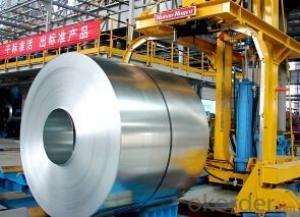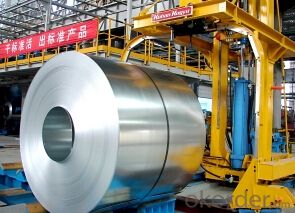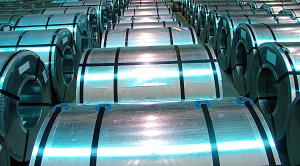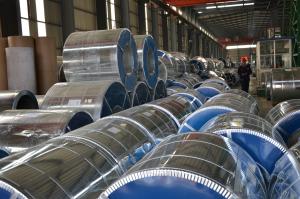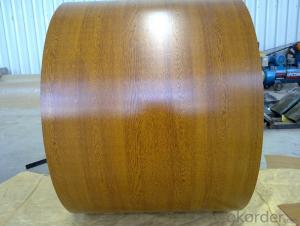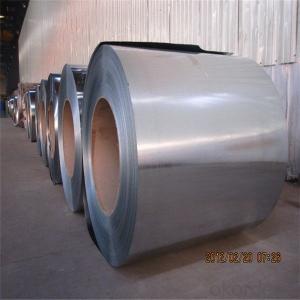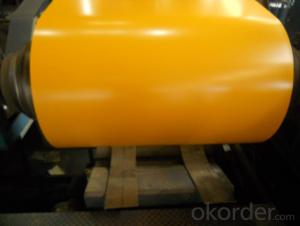Alu Zinc Coated Steel Coils for Constructions
- Loading Port:
- Tianjin
- Payment Terms:
- TT OR LC
- Min Order Qty:
- 30 m.t.
- Supply Capability:
- 10000 m.t./month
OKorder Service Pledge
OKorder Financial Service
You Might Also Like
Description Basic Info.
Model NO.:0.50*1000*C
Surface Treatment:Alu-Zinc Coated
Technique:Cold Rolled
Standard:ASTM, JIS, GB, DIN, BS
Steel Grade:Dx51d-Az
Thickness 0.15mm to 3.00mm:Coil Width 600mm to 1250mm
Export Markets:Global
Additional Info.
Packing:Seaworthy, Standard Export Package, in Container
Standard:JIS G3321 SGLCC & DX51D-AZ
Origin:China
HS Code:7210610000
Production Capacity:150, 000 Metric Tons/Year
Product Description
Galvalume steel coils as follows:
1) Quality standard of galvalume steel coils: JIS G3302 SGCC, DX51D and ASTM A653
2) Grade of galvalume steel coils: SGCC (DX51D+Z) and SGHC
3) Hardness of galvalume steel coils: Both soft and hard quality are available
4) Surface finish of galvalume steel coils: Regular spangle, big spangle and zero spangle
5) Thickness of galvalume steel coils: SGCC 0.14-2.0 mm, SGHC 1.80-5.00mm
6) Width of galvalume steel coils: 914mm, 1000mm, 1220mm and 1250mm, thickness 600-1250mm is available
7) Finish by coil or sheet for galvalume steel coils: Both sheet and coil are available
8) Zinc coating of galvalume steel coils: 60-275G/M2, both sides
9) Weight per galvalume steel coils: 4-8 tons, also can be upon customer's requirements
10) Max loading weight in one 20ft container for galvalume steel coils: 25 tons generally
11) MOQ of galvalume steel coils: 25 tons for each item;
12) Actual shipping quantity of galvalume steel coils: More or less 10% generally;
13) Delivery time for galvalume steel coils: 15 days ganerally.
12) Applications of galvalume steel coils: Widely used for roofs, outer walls, ovens, explosive-proof steel, electrically controlled cabinets, and industrial freezers in the residential and industrial buildings.
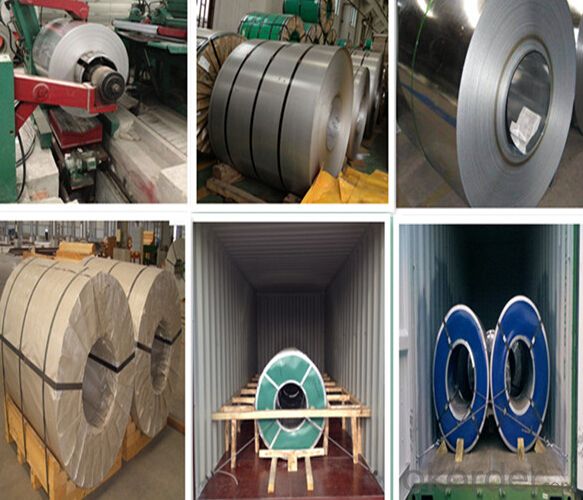
FAQ
1.What's your MOQ?
25MT, it is for one container.
2.Do you have QC teams?
Yeah, sure, our QC team is very important, they will keep the quality control for our products.
3. What's your normal delivery time?
Our delivery time about 10-20days for standard sizes, if you have other requirements like hardness and width ,it is about 20-40days. But don't worry ,we also try our best for the delivery time ,because time longer and our cost is higher.
4.Are the products tested before shipping?
Yes, all of our PPGI and GI was qualified before shipping. We test every batch every day.
- Q: What are the factors driving the growth of the steel coil industry?
- There are several factors driving the growth of the steel coil industry. Firstly, the increasing demand for steel coils in various sectors such as automotive, construction, and manufacturing is a significant driver. Additionally, the expanding infrastructure projects and urbanization in emerging economies contribute to the growth of the industry. Moreover, technological advancements in steel manufacturing processes and the adoption of efficient production techniques also play a crucial role in driving the growth of the steel coil industry.
- Q: Can steel coils be painted?
- Yes, steel coils can be painted. Painting steel coils is a common practice to enhance their appearance, protect them from corrosion, and provide additional durability. The coils are typically cleaned, prepped, and coated with a primer before applying the desired paint color.
- Q: What is the minimum order quantity for steel coils?
- The minimum order quantity for steel coils can vary depending on the supplier and specific product requirements. It is best to consult with the supplier or manufacturer directly to determine their minimum order quantity.
- Q: I have several stainless steel utensils and appliances, so when I put them through the dishwasher some of them are rusting, I think its because my current dishwashing soap is harsh, what is some great dishwashing soap that will clean my dishes and not be so hard on my stainless steel appliances and utensils?
- Sorry to tell you this, but it is the quality of the stainless steel utensils. I had the same problem in the past. It pays to spend a little more when you plan to wash your silverware in the dishwasher. I did and I am very happy with the new silverware. I never changed my detergent, just a better quality silverware.
- Q: What are the common industry standards for steel coils?
- The common industry standards for steel coils include specifications related to dimensions, weight, chemical composition, mechanical properties, and surface finish. These standards are often set by organizations such as the American Society for Testing and Materials (ASTM), International Organization for Standardization (ISO), and the Steel Industry Associations.
- Q: I'm kind of confused as to how the difference between a stainless steel and blued steel firearm is sometimes only $20 or so. Isn't stainless steel fairly more expensive to manufacture than plain carbon steel? Are some stainless steel firearms simply stainless steel finished with carbon steel underneath?
- I don't know that stainless can be laminated to steel very easily. Stainless is a little more expensive. The problem comes in that stainless is much harder to machine that normal gun steel. With laminated steel, you would still have the problem of machining the stainless. Occasionally firearms are nickle plated or barrels are chrome lined.
- Q: What are the different types of steel coil finishes for aesthetics?
- There are multiple varieties of steel coil finishes utilized for aesthetic purposes, each offering a distinct appearance and texture to the steel surface. Some of the most prevalent finishes include: 1. Matte finish: This finish boasts a low-gloss appearance, providing a smooth and non-reflective surface. It imparts a clean and contemporary look to the steel coil, making it suitable for a range of architectural and interior design applications. 2. Brushed finish: Also referred to as a satin finish, this type of finish is achieved by brushing the steel surface with a fine abrasive material. It produces a subtle and directional grain pattern, resulting in a textured appearance. Brushed finishes are commonly employed in kitchen appliances, decorative elements, and furniture. 3. Mirror finish: As the name suggests, this finish creates an intensely reflective surface similar to a mirror. It is accomplished through the process of polishing the steel surface to a high shine using abrasive materials. Mirror finishes find common usage in architectural applications like decorative panels, elevator doors, and signage. 4. Patterned finish: This finish involves embossing or etching a pattern onto the steel surface, ranging from simple geometric designs to intricate textures. It offers a unique and visually captivating appearance. Patterned finishes are widely used in interior design, automotive trims, and decorative panels. 5. Textured finish: Textured finishes are created by applying a texture to the steel surface, such as a stucco or diamond pattern. This enhances depth and visual interest, making it suitable for various applications including wall cladding, roofing, and garage doors. 6. Colored finish: Apart from different surface textures, steel coils can also be finished with a variety of colors. This is achieved by applying a coating or paint system, which enhances both the aesthetic appeal and protection against corrosion. Colored finishes are commonly employed in architectural applications such as building facades, window frames, and decorative elements. Ultimately, the choice of steel coil finish depends on the desired aesthetic outcome, as well as the specific requirements and intended application of the steel product.
- Q: What are the different types of steel grades used for coil production?
- There are various types of steel grades used for coil production, including carbon steel, stainless steel, and high-strength low-alloy (HSLA) steel. These grades are selected based on the specific requirements and application of the coils, such as strength, corrosion resistance, and formability.
- Q: I'm in the middle of a remodel and buying appliances. Is there any way to ensure that the stainless steel is the same tone if you get different brands?
- it doesn't really matter. I have all appliances in my kitchen stainless steel. All different makes never noticed the tone, I think it just depends on the grain. i clean my appliances side to side not up and down. Good question never thought about that.
- Q: How are steel coils protected from humidity?
- Steel coils are typically protected from humidity through a process called galvanization, where a layer of zinc or another protective coating is applied to the surface of the steel. This coating acts as a barrier, preventing moisture from coming into direct contact with the steel and minimizing the risk of corrosion. Additionally, steel coils are often stored in dry, enclosed spaces or wrapped with moisture-resistant materials such as plastic or wax paper to further protect them from humidity.
Send your message to us
Alu Zinc Coated Steel Coils for Constructions
- Loading Port:
- Tianjin
- Payment Terms:
- TT OR LC
- Min Order Qty:
- 30 m.t.
- Supply Capability:
- 10000 m.t./month
OKorder Service Pledge
OKorder Financial Service
Similar products
Hot products
Hot Searches
Related keywords

